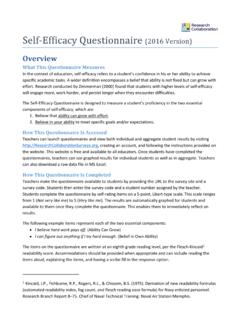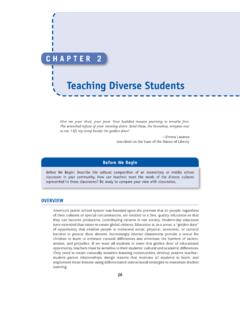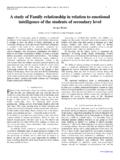Transcription of Radiography Students’ Perceptions and Experiences of their ...
1 East African Scholars Journal of Medical Sciences Abbreviated Key Title: East African Scholars J Med Sci ISSN 2617-4421 (Print) | ISSN 2617-7188 (Online) | Published By East African Scholars Publisher, Kenya Volume-2 | Issue-7| July -2019 | Quick Response Code Journal homepage: Copyright @ 2019: This is an open-access article distributed under the terms of the Creative Commons Attribution license which permits unrestricted use, distribution, and reproduction in any medium for non commercial use (NonCommercial, or CC-BY-NC) provided the original author and source are credited.
2 Article History Received: Accepted: Published: Published By East African Scholars Publisher, Kenya 367 Original Research Article Radiography students Perceptions and Experiences of their Clinical Placements: A Qualitative Systematic Review Osward Bwanga1 and Dr Joanne Lidster2 1 Midland Regional Hospital at Tullamore, Radiology Department, Ireland. 2 Sheffield Hallam University, England. *Corresponding Author Osward Bwanga Abstract: Clinical placements provide opportunities for Radiography students to apply theory into practice. Several primary research studies on the Perceptions and Experiences of Radiography students regarding their clinical placements have been conducted.
3 However, no study has systematically brought these studies together to provide a template for educators to develop a set of clinical supervision strategies that are grounded on evidence. The aim of this study was, therefore, to systematically review the evidence relating to Radiography students Perceptions and Experiences of their placements. In achieving this, a qualitative systematic review was conducted. Electronic databases, Radiography and radiotherapy journals, and grey literature were searched for relevant primary studies.
4 Data extraction was performed using the Valderas s extraction form and the National Institute for Health and Care Excellence (NICE) checklist for qualitative studies to critically appraise the studies. Eight themes emerged following thematic data analysis: clinical learning environment, theory- practice gap, hands-on practice, feedback on clinical performance, teaching and learning of professionalism, emotional aspect of working with patients, qualities of an effective and an ineffective clinical supervisor, and the relationship between the schools of Radiography and clinical departments.
5 Factors related to these themes positively or negatively impacted the students learning process. In conclusion, there are many lessons to be learnt in continuing to improve the quality of Radiography students clinical placements. Stakeholders should work together to create a conducive clinical learning environment, whereby Radiography students can develop their knowledge, skills and attitudes to become professional radiographers. This can be achieved through developing educational strategies based on evidence, such as provided in this systematic review. Keywords: Qualitative, Systematic review, Clinical placement, Clinical supervision, Clinical supervisor, Radiographer, Radiography student, Perception, Experience.
6 INTRODUCTION Clinical placements are an integral component of the Radiography programmes worldwide. Radiography students spend approximately 50% of their training time on clinical placement in hospitals affiliated with the schools of Radiography . The College of Radiographers of the United Kingdom (2006) notes that, during clinical placements, students learn by having planned periods of observation, education, reflection, and work alongside their clinical supervisors. This enables them to acquire the necessary knowledge, attitudes and skills of the Radiography profession as required by regulators and professional bodies, such as the Health Professions Council of Zambia and Radiological Society of Zambia, respectively.
7 Clinical placements in Radiography are important from many aspects. From a regulatory point of view, practice in clinical learning environment is required to ensure fitness to practice as a radiographer. From an educational perspective, working with a patient provides students with the opportunity to apply theory into practice. Ogbu (2008) points out that clinical placement enhances the development of independent learning skills that are fundamental in producing critical and analytical thinkers. During clinical placement, students have the opportunity to observe role models, practice, and reflect upon what they see, hear and do (Conway et al.)
8 , 2008; Challen et al., 2016). From a clinical supervisor s perspective, clinical placements assist radiographers develop teaching, management and communication skills. Walsh (2014) adds that a sense Osward Bwanga &Joanne Lidster; East African Scholars J Med Sci; Vol-2, Iss- 7 (July, 2019): 367-380 East African Scholars Publisher, Kenya 368 of personal satisfaction in facilitating the development of students sharing practice and enhancing learning, may result. The College of Radiographers of the UK (2012) has emphasised the need to have conducive clinical learning environments for Radiography students .
9 However, it is challenging to provide a suitably conducive environment for learning because practice-based learning takes place in a demanding and complex environment where patient care is provided as well as student learning. Radiography students learn in a complex sociotechnical environment, often with critically ill patients, and are themselves at risk from ionising radiation. Learning activities are also unstructured and unplanned. For this reason, Radiography students may experience a lot of factors which may facilitate or inhibit their clinical learning process.
10 The Health Department of Australia and Human Services (2016) categorises these factors into internal and external. The internal factors are those which are controlled by the clinical departments, such as equipment, staffing levels, resources, departmental policies and preparations of clinical supervisors. On the other hand, external factors are those not controlled by the clinical department, such as patient case load, levels of funding, accreditation requirements and professional standards. In view of the above, Radiography students experience challenges during their clinical placements.







